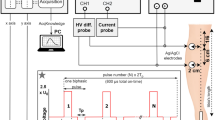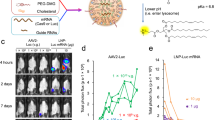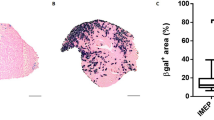Abstract
Efficient DNA electrotransfer into muscles can be achieved by combining two types of electronic pulses sequentially: short high-voltage (HV) pulse for the cell electropermeabilization and long low-voltage (LV) pulse for the DNA electrophoresis into cells. However, the voltages currently applied can still induce histological and functional damages to tissues. Pluronic L64 has been considered as a molecule possessing cell membrane-disturbing ability. For these reasons, we hope that L64 can be used as a substitute for the HV pulse in cell membrane permeabilization, and a safe LV pulse may still keep the ability to drive plasmid DNA across the permeabilized membrane. In this work, we optimized the electrotransfer parameters to establish a safe and efficient procedure using a clinically applied instrument, and found out that the critical condition for a successful combination of electrotransfer with L64 was that the injection of plasmid/L64 mixture should be applied 1 h before the electrotransfer. In addition, we revealed that the combined procedure could not efficiently transfer plasmid into solid tumor because the uncompressed plasmid may rapidly permeate the leaky tumor vessels and flow away. Altogether, the results demonstrate that the combined procedure has the potential for plasmid-based gene therapy through safe and efficient local gene delivery into skeletal muscles.
This is a preview of subscription content, access via your institution
Access options
Subscribe to this journal
Receive 12 print issues and online access
$259.00 per year
only $21.58 per issue
Buy this article
- Purchase on Springer Link
- Instant access to full article PDF
Prices may be subject to local taxes which are calculated during checkout






Similar content being viewed by others
References
Niidome T, Huang L . Gene therapy progress and prospects: nonviral vectors. Gene Therapy 2002; 9: 1647–1652.
Kay MA, Glorioso JC, Naldini L . Viral vectors for gene therapy: the art of turning infectious agents into vehicles of therapeutics. Nat Med 2001; 7: 33–40.
Ferber D . Safer and virus-free? Science 2001; 294: 1638–1642.
Mintzer MA, Simanek EE . Nonviral vectors for gene delivery. Chen Rev 2008; 109: 259–302.
Somiari J, Glasspool-Malone J, Drabick JJ, Gilbert RA, Heller R, Jaroszeski MJ et al. Theory and in vivo application of electroporative gene delivery. Mol Ther 2000; 2: 178–187.
Mullins LJ . An analysis of pore size in excitable membranes. J Gen Physiol 1960; 43: 105–117.
Neumann E, Schaefer-Ridder M, Wang Y, Hofschneider PH . Gene transfer into mouse lyoma cells by electroporation in high electric fields. EMBO J 1982; 1: 841–845.
Titomirov AV, Sukharev S, Kistanova E . In vivo electroporation and stable transformation of skin cells of newborn mice by plasmid DNA. Biochim Biophys Acta 1991; 1088: 131–134.
Mir LM, Bureau MF, Gehl J, Rangara R, Rouy D, Caillaud JM et al. High-efficiency gene transfer into skeletal muscle mediated by electric pulses. Proc Natl Acad Sci USA 1999; 96: 4262–4267.
Chabot S, Rosazza C, Golzio M, Zumbusch A, Teissié J, Rols MP . Nucleic acids electro-transfer: from bench to bedside. Curr Drug Metab 2013; 14: 300–308.
Bureau MF, Gehl J, Deleuze V, Mir LM, Scherman D . Importance of association between permeabilization and electrophoretic forces for intramuscular DNA electrotransfer. Biochim Biophys Acta 2000; 1474: 353–359.
Satkauskas S, Bureau MF, Puc M, Mahfoudi A, Scherman D, Miklavcic D et al. Mechanisms of in vivo DNA electrotransfer: respective contributions of cell electropermeabilization and DNA electrophoresis. Mol Ther 2002; 5: 133–140.
Hartikka J, Sukhu L, Buchner C, Hazard D, Bozoukova V, Margalith M et al. Electroporation-facilitated delivery of plasmid DNA in skeletal muscle: plasmid dependence of muscle damage and effect of poloxamer 188. Mol Ther 2001; 4: 407–415.
Durieux AC, Bonnefoy R, Busso T, Freyssenet. D . In vivo gene electrotransfer into skeletal muscle: effects of plasmid DNA on the occurrence and extent of muscle damage. J Gene Med 2004; 6: 809–816.
Satkauskas S, Andre F, Bureau MF, Scherman D, Miklavcic D, Mir LM . Electrophoretic component of electric pulses determines the efficacy of in vivo DNA electrotransfer. Hum Gene Ther 2005; 16: 1194–1201.
André F, Mir LM . DNA electrotransfer: its principles and an updated review of its therapeutic applications. Gene Therapy 2004; 11: S33–S42.
Al-Dosari MS, Gao X . Nonviral gene delivery: principle, limitations, and recent progress. AAPS J 2009; 11: 671–681.
Nicolas J, Mura S, Brambilla D, Mackiewicz N, Couvreur P . Design, functionalization strategies and biomedical applications of targeted biodegradable/biocompatible polymer-based nanocarriers for drug delivery. Chem Soc Rev 2013; 42: 1147–1235.
Kabanov AV, Lemieux P, Vinogradov S, Alakhov V . Pluronic block copolymers: novel functional molecules for gene therapy. Adv Drug Deliv Rev 2002; 54: 223–233.
Richard P, Bossard F, Desigaux L, Lanctin C, Bello-Roufai M, Pitard B . Amphiphilic block copolymers promote gene delivery in vivo to pathological skeletal muscles. Hum Gene Ther 2005; 16: 1318–1324.
Pitard B, Pollard H, Agbulut O, Lambert O, Vilquin JT, Cherel Y et al. A nonionic amphiphile agent promotes gene delivery in vivo to skeletal and cardiac muscles. Hum Gene Ther 2002; 13: 1767–1775.
Gau-Racine J, Lal J, Zeghal M, Auvray L . PEO-PPO block copolymer vectors do not interact directly with DNA but with lipid membranes. J Phys Chem B 2007; 111: 9900–9907.
Alimi-Guez D, Leborgne C, Pembouong G, Van Wittenberghe L, Mignet N, Scherman D et al. Evaluation of the muscle gene transfer activity of a series of amphiphilic triblock copolymers. J Gene Med 2009; 11: 1114–1124.
Orlowski S, Mir LM . Cell electropermeabilization: a new tool for biochemical and pharmacological studies. Biochim Biophys Acta 1993; 1154: 51–63.
Wells DJ . Gene therapy progress and prospects: electroporation and other physical methods. Gene Therapy 2004; 11: 1363–1369.
Rols MP, Teissié J . Electropermeabilization of mammalian cells to macromolecules: control by pulse duration. Biophys J 1998; 75: 1415–1423.
Liu F, Sag D, Wang J, Shollenberger LM, Niu F, Yuan X et al. Sine-wave current for efficient and safe in vivo gene transfer. Mol Ther 2007; 15: 1842–1847.
Bureau MF, Wasungu L, Jugé L, Scherman D, Rols MP, Mignet N . Investigating relationship between transfection and permeabilization by the electric field and/or the Pluronic L64 in vitro and in vivo. J Gene Med 2012; 14: 204–215.
Wasungu L, Marty AL, Bureau MF, Kichler A, Bessodes M, Teissie J et al. Pre-treatment of cells with pluronic L64 increases DNA transfection mediated by electrotransfer. J Control Rel 2011; 149: 117–125.
Schertzer JD, Plant DR, Lynch GS . Optimizing plasmid-based gene transfer for investigating skeletal muscle structure and function. Mol Ther 2006; 13: 795–803.
Yu JL, May L, Lhotak V, Shahrzad S, Shirasawa S, Weitz JI et al. Oncogenic events regulate tissue factor expression in colorectal cancer cells: implications for tumor progression and angiogenesis. Blood 2005; 105: 1034–1041.
Maeda H, Nakamura H, Fang J . The EPR effect for macromolecular drug delivery to solid tumors: improvement of tumor uptake, lowering of systemic toxicity, and distinct tumor imaging in vivo. Adv Drug Deliv Rev 2013; 65: 71–79.
Blomberg P, Eskandarpour M, Xia S, Sylvén C, Islam KB . Electroporation in combination with a plasmid vector containing SV40 enhancer elements results in increased and persistent gene expression in mouse muscle. Biochem Biophys Res Commun 2002; 298: 505–510.
Acknowledgements
This work was supported by the National Basic Research Program of China (973 program, No. 2011CB606206), National Natural Science Foundation of China (No. 31370972, 51133004, 81361140343) and National Support Program of Science and Technology (No. 2012BAI17B06). We would like to thank Jordan Petkov (Unilever R&D Port Sunlight) for his critical reading of this manuscript.
Author information
Authors and Affiliations
Corresponding authors
Ethics declarations
Competing interests
The authors declare no conflict of interest.
Rights and permissions
About this article
Cite this article
Liu, S., Ma, L., Tan, R. et al. Safe and efficient local gene delivery into skeletal muscle via a combination of Pluronic L64 and modified electrotransfer. Gene Ther 21, 558–565 (2014). https://doi.org/10.1038/gt.2014.27
Received:
Revised:
Accepted:
Published:
Issue Date:
DOI: https://doi.org/10.1038/gt.2014.27



